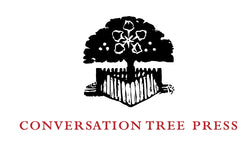Weird. Fine press weird fiction from S.T. Joshi

The first volume in the Weird. collection will be The House on the Borderland and Others by William Hope Hodgson with illustrations by Dave McKean. Stay subscribed to our newsletter to learn more as production continues.
Over the past few years, there has been renewed interest in Weird Fiction written by some of the genre’s earliest practitioners, due in no small part to the research and relentless effort by scholars to catalog and bring just attention to their work. And while this work has made Weird fiction more accessible today, well-deserved fine press treatments are few and far between. When they are published, the limitation is often quite small and they veer into livre d’artiste territory, putting them out of reach of many collectors.
Conversation Tree Press aims to correct this. We’ve started production of Weird., a planned collection of twenty fine press weird fiction volumes curated, edited and introduced by S.T. Joshi. As a scholar who has dedicated most of his career to researching, writing and editing collections on many of the genre’s leading authors, and an authority on the genre as a whole, this collection draws from the work done throughout his entire career. We can think of no one better suited to collaborate with on this.
Each volume in the collection will be letterpress-printed, handsomely bound and include only the finest tales and poetry from the genre’s most impressive authors, including Ambrose Bierce, Arthur Machen, William Hope Hodgson, Algernon Blackwood, H.P. Lovecraft, Lord Dunsany, and many others.
One or two volumes will be published each year with original artwork in Standard, Deluxe and Lettered states. The Weird. collection will have its own set of rights starting from Volume 1, which will branch off from the most recently published book at that time. More details will be shared as we go deeper into production.
What is Weird Fiction?
Weird fiction is a subgenre of speculative fiction that combines elements of horror, fantasy, and science fiction. It is characterized by its focus on the unknown and the supernatural, often featuring otherworldly or cosmic elements that challenge the reader’s understanding of reality.
Weird fiction can be traced back to the 19th century, with Edgar Allan Poe (1809-1849) regarded as the first author in the genre, though the name itself did not appear until the 20th century. H.P. Lovecraft (1890-1937) popularized the term “weird fiction” in his essays, giving it this definition:
The true weird tale has something more than secret murder, bloody bones, or a sheeted form clanking chains according to rule. A certain atmosphere of breathless and unexplainable dread of outer, unknown forces must be present; and there must be a hint, expressed with a seriousness and portentousness becoming its subject, of that most terrible conception of the human brain—a malign and particular suspension or defeat of those fixed laws of Nature which are our only safeguard against the assaults of chaos and the daemons of unplumbed space.
Some common themes in weird fiction include human fear of the unknown, cosmic horror, exploration of the human psyche, the breakdown of reality, and the blurring of the lines between different dimensions or realities. Many works of weird fiction also deal with themes of isolation, decay, and the passage of time.
